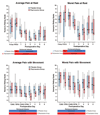Ambulatory continuous femoral nerve blocks decrease time to discharge readiness after tricompartment total knee arthroplasty: a randomized, triple-masked, placebo-controlled study
- PMID: 18362603
- PMCID: PMC2643303
- DOI: 10.1097/ALN.0b013e318167af46
Ambulatory continuous femoral nerve blocks decrease time to discharge readiness after tricompartment total knee arthroplasty: a randomized, triple-masked, placebo-controlled study
Abstract
Background: The authors tested the hypotheses that, compared with an overnight continuous femoral nerve block (cFNB), a 4-day ambulatory cFNB increases ambulation distance and decreases the time until three specific readiness-for-discharge criteria are met after tricompartment total knee arthroplasty.
Methods: Preoperatively, all patients received a cFNB (n = 50) and perineural ropivacaine 0.2% from surgery until the following morning, at which time they were randomly assigned to either continue perineural ropivacaine or switch to perineural normal saline. Primary endpoints included (1) time to attain three discharge criteria (adequate analgesia, independence from intravenous analgesics, and ambulation of at least 30 m) and (2) ambulatory distance in 6 min the afternoon after surgery. Patients were discharged with their cFNB and a portable infusion pump, and catheters were removed on postoperative day 4.
Results: Patients given 4 days of perineural ropivacaine attained all three discharge criteria in a median (25th-75th percentiles) of 25 (21-47) h, compared with 71 (46-89) h for those of the control group (estimated ratio, 0.47; 95% confidence interval, 0.32-0.67; P <0.001). Patients assigned to receive ropivacaine ambulated a median of 32 (17-47) m the afternoon after surgery, compared with 26 (13-35) m for those receiving normal saline (estimated ratio, 1.21; 95% confidence interval, 0.71-1.85; P = 0.42).
Conclusions: Compared with an overnight cFNB, a 4-day ambulatory cFNB decreases the time to reach three important discharge criteria by an estimated 53% after tricompartment total knee arthroplasty. However, the extended infusion did not increase ambulation distance the afternoon after surgery. (ClinicalTrials.gov No. NCT00135889.).
Figures





References
-
- Ilfeld BM, Enneking FK. Continuous peripheral nerve blocks at home: A review. Anesth Analg. 2005;100:1822–1833. - PubMed
-
- Ilfeld BM, Gearen PF, Enneking FK, Berry LF, Spadoni EH, George SZ, Vandenborne K. Total knee arthroplasty as an overnight-stay procedure using continuous femoral nerve blocks at home: A prospective feasibility study. Anesth Analg. 2006;102:87–90. - PubMed
-
- Singelyn FJ, Deyaert M, Joris D, Pendeville E, Gouverneur JM. Effects of intravenous patient-controlled analgesia with morphine, continuous epidural analgesia, and continuous three-in-one block on postoperative pain and knee rehabilitation after unilateral total knee arthroplasty. Anesth Analg. 1998;87:88–92. - PubMed
-
- Capdevila X, Barthelet Y, Biboulet P, Ryckwaert Y, Rubenovitch J, d’Athis F. Effects of perioperative analgesic technique on the surgical outcome and duration of rehabilitation after major knee surgery. Anesthesiology. 1999;91:8–15. - PubMed
-
- Todd MM, Brown DL. Regional anesthesia and postoperative pain management: Long-term benefits from a short-term intervention. Anesthesiology. 1999;91:1–2. - PubMed
Publication types
MeSH terms
Associated data
Grants and funding
LinkOut - more resources
Full Text Sources
Other Literature Sources
Medical
Miscellaneous

